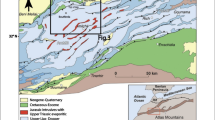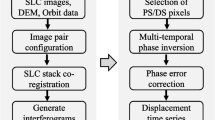Abstract
When modelling a stratified orebody, accurately representing the dip and dip direction is important for accurate resource estimation. In the banded iron formation-hosted iron ore deposits in the Pilbara region of Western Australia, these quantities can be determined using marker shales from nearby holes. These marker shales are identified using natural gamma logs and are generally manually processed. Therefore, an automated method for matching natural gamma logs between holes is desirable. Dynamic time warping (DTW) can match two signals where there is stretching or distortion. This study presents a modified, iterative version of DTW for matching downhole natural gamma logs. This new method accounts for large differences in length of the two signals by comparing different segments of the signals. Several metrics were then used to rank potential matches between signals. The proposed iterative DTW method had an accuracy of 90%, compared with 67% for the standard DTW. Once matched, signals can be used to estimate the bedding angle at each hole. A point in one hole was matched to as many nearby holes as possible, creating a set of points located on the same surface. A localized plane was then fitted to these points. These bedding angles were used to reconstruct a surface representing the bedding. While the signal matching was accurate, the sparsity of correctly matched holes limits the accuracy of the calculated surface. Even with sparse gradient fields, a reasonable approximation of the bedding could be achieved.









Similar content being viewed by others
References
Agrawal R, Lin K-I, Sawhney H, Shim K (1997) Fast similarity search in the presence of noise, scaling, and translation in time-series databases. Paper presented at the 21st international conference on very large databases, Zurich, Switzerland
Bubnova A, Ors F, Rivoirard J, Cojan I, Romary T (2020) Automatic determination of sedimentary units from well data. Math Geosci 52:213–231. https://doi.org/10.1007/s11004-019-09793-w
Clifford D et al (2009) Alignment using variable penalty dynamic time warping. Anal Chem 81:1000–1007. https://doi.org/10.1021/ac802041e
Dalstra HJ, Rosiere CA (2008) Structural controls on high-grade iron ores hosted by banded iron formation: a global perspective. In: Hagemann S, Rosiere C, Gutzmer J, Beukes NJ (eds) Banded iron formation-related high-grade iron ore, vol 15. Reviews in Economic Geology. Society of Econimic Geologists, INC, Littleton, CO, pp 73–106
D'Errico J (2012) inpaint_nans. MATLAB Central File Exchange
Harker M, O'Leary P (2013) Surface Reconstruction from Gradient Fields: grad2Surf Version 1.0. MATLAB Central File Exchange
Harmsworth RA, Kneeshaw M, Morris RC, Robinson CJ, Shrivastava PK (1990) BIF-derived iron ores of the Hamersley province. In: Hughes FE (ed) Geology of the mineral deposits of Australia and Papua New Guinea. The Australasian Institute of Mining and Metallurgy, Melbourne, pp 617–642
Hill EJ, Robertson J, Uvarova Y (2015) Multiscale hierarchical domaining and compression of drill hole data. Comput Geosci 79:47–57
Hill EJ, Pearce MA, Stromberg JM (2021) Improving automated geological logging of drill holes by incorporating multiscale spatial methods. Math Geosci 53:21–53. https://doi.org/10.1007/s11004-020-09859-0
Kadkhodaie A, Rezaee R (2017) Intelligent sequence stratigraphy through a wavelet-based decomposition of well log data. J Nat Gas Sci Eng 40:38–50. https://doi.org/10.1016/j.jngse.2017.02.010
Keogh E, Pazzani M (2002) Derivative dynamic time warping. First SIAM international conference on data Mining, vol 1, https://doi.org/10.1137/1.9781611972719.1
Keogh E, Ratanamahatana CA (2005) Exact indexing of dynamic time warping. Knowl Inf Syst 7:358–386. https://doi.org/10.1007/s10115-004-0154-9
Lascelles DF (2000) Marra Mamba Iron Formation stratigraphy in the eastern Chichester Range, Western Australia. Aust J Earth Sci 47:799–806. https://doi.org/10.1046/j.1440-0952.2000.00810.x
Mueen A, Keogh E (2016) Extracting optimal performance from dynamic time warping. Paper presented at the Proceedings of the 22nd ACM SIGKDD international conference on knowledge discovery and data mining, San Francisco, California, USA, https://doi.org/10.1145/2939672.2945383
Quiniou T, Selmaoui N, Christine L-M (2007) Calculation of bedding angles inclination from drill core digital images. Paper presented at the IAPR conference on machine vision applications, Tokyo, Japan
Rabiner L, Juang B-H (1993) Fundamentals of speech recognition. Prentice-Hall, Inc., Englewood Cliffs
Ratanamahatana C, Keogh E (2004) Everything you know about dynamic time warping is wrong. Paper presented at the 3rd international workshop on mining temporal and sequential data (TDM-04), Seattle, USA
Silversides KL, Melkumyan A (2016) A Dynamic Time Warping based covariance function for Gaussian Processes signature identification. Comput Geosci 96:69–76. https://doi.org/10.1016/j.cageo.2016.08.001
Silversides K, Melkumyan A, Wyman D (2015a) Automated lithological recognition using DTW signal processing of natural gamma logs. Paper presented at the application of computers and operations research in the mineral industry (APCOM 2015), Alaska, USA
Silversides K, Melkumyan A, Wyman D, Hatherly P (2015b) Automated recognition of stratigraphic marker shales from geophysical logs in iron ore deposits. Comput Geosci 77:118–125. https://doi.org/10.1016/j.cageo.2015.02.002
Sommerville B, Boyle C, Brajkovich N, Savory P, Latscha AA (2014) Mineral resource estimation of the Brockman 4 iron ore deposit in the Pilbara region. Appl Earth Sci 123:135–145. https://doi.org/10.1179/1743275814Y.0000000038
Taylor D, Dalstra HJ, Harding AE, Broadbent GC, Barley ME (2001) Genesis of high-grade hematite orebodies of the Hamersley province, Western Australia. Econ Geol Bull Soc Econ Geol 96:837–873. https://doi.org/10.2113/gsecongeo.96.4.837
Thorne W, Hagemann S, Webb A, Clout J (2008) Banded iron formation-related iron ore deposits of the Hammersley Province, Western Australia. In: Hagemann S, Rosiere C, Gutzmer J, Beukes N (eds) Reviews in economic geology: banded iron formation-related high-grade iron ore, vol 15. Society of Economic Geologists. Westminster, USA, pp 197–221
Tofallis C (2014) Add or multiply? A tutorial on ranking and choosing with multiple criteria. INFORMS Trans Edu 14:109–119. https://doi.org/10.1287/ited.2013.0124
Trendall AF, Blockley JG (1968) Stratigraphy of the dales gorge member of the Brockman iron formation, in the Precambrian Hamersley Group of Western Australia. Western Australia Geological Survey
Zaiontz C (2012) Real statistics using excel. http://www.real-statistics.com/correlation/basic-concepts-correlation/.
Acknowledgements
This work has been supported by the Australian Centre for Field Robotics and the Rio Tinto Centre for Mine Automation.
Author information
Authors and Affiliations
Corresponding author
Rights and permissions
About this article
Cite this article
George, M.A., Silversides, K.L., Zigman, J. et al. Bedding Angle Identification from BIF Marker Shales via Modified Dynamic Time Warping. Math Geosci 53, 1567–1585 (2021). https://doi.org/10.1007/s11004-021-09936-y
Received:
Accepted:
Published:
Issue Date:
DOI: https://doi.org/10.1007/s11004-021-09936-y




